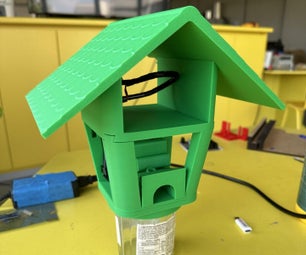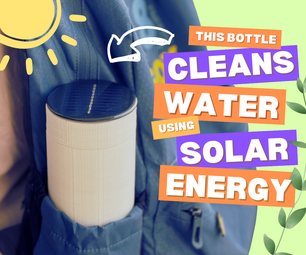Introduction: Create Your Own Electronic Game Kit
Originally designed for the Maker Faire by Grand Idea Studio, the "Build Your Own Electronic Game Kit" is a custom-created kit intended to introduce you to the world of electronics and soldering. When successfully assembled, the kit becomes a version of the popular memory game, Simon, with a few optional twists. It's available on the MAKE store.
This kit is extremely simple to construct even for beginners! If you need something to practice your soldering on (and get a cool result), get this. To learn the basics of soldering check out this great guide by noahw. Also, here's a good video tutorial from the MAKE blog.
Instructions are conveniently printed on the back of the unit, and most components don't need to go in in specific orientation. (Only the LEDs and IC -- so watch out for those steps). Also there are a couple of modes you can select depending on how you turn the game on.
This kit is extremely simple to construct even for beginners! If you need something to practice your soldering on (and get a cool result), get this. To learn the basics of soldering check out this great guide by noahw. Also, here's a good video tutorial from the MAKE blog.
Instructions are conveniently printed on the back of the unit, and most components don't need to go in in specific orientation. (Only the LEDs and IC -- so watch out for those steps). Also there are a couple of modes you can select depending on how you turn the game on.
Step 1: What You Get and What You Need.
The kit's instructions are printed on the underside, including what you're supposed to get with it. That boils down to:
What you get:
4 LEDs
2 1k ohm Resistors R1, R3 - brown, black, red
2 3.3k ohm Resistors R2, R5 - orange, orange, red
2 330 ohm Resistors R4, R6 - orange, orange, brown
1 0.1 uF Capacitor C1
4 Buttons
1 Switch
1 Battery + Holder
1 IC PIC16LF648A
1 PCB
1 Speaker LS1
You'll need the typical soldering tools
What you need:
Solder
Clippers
Soldering iron
What you get:
4 LEDs
2 1k ohm Resistors R1, R3 - brown, black, red
2 3.3k ohm Resistors R2, R5 - orange, orange, red
2 330 ohm Resistors R4, R6 - orange, orange, brown
1 0.1 uF Capacitor C1
4 Buttons
1 Switch
1 Battery + Holder
1 IC PIC16LF648A
1 PCB
1 Speaker LS1
You'll need the typical soldering tools
What you need:
Solder
Clippers
Soldering iron
Step 2: IC + C1
The instructions on the kit suggest putting the IC in first, but if you've never soldered anything before, maybe you should do this last. Heat can damage the circuit. The kit's simplicity will probably prevent damage, but if you're not sure just put it on last.
Put the IC in into board with the little U on the IC matching the U on the board. (See photo)
You can bend the prongs back a little back when you put it in so it doesn't fall out, but you'd be better off just holding in place as you solder.
Now do the C1:
Put the C1 into it's spot on the board, and bend the wire's legs back so it doesn't fall out when you turn the board over to solder.
Cut off the excess wire when you're done.
Put the IC in into board with the little U on the IC matching the U on the board. (See photo)
You can bend the prongs back a little back when you put it in so it doesn't fall out, but you'd be better off just holding in place as you solder.
Now do the C1:
Put the C1 into it's spot on the board, and bend the wire's legs back so it doesn't fall out when you turn the board over to solder.
Cut off the excess wire when you're done.
Step 3: Resistors
There are 3 types of resistors, and they're described on the back of the unit.
R1, R3 - brown, black, red
R2, R5 - orange, orange, red
R4, R6 - orange, orange, brown
Put them in and solder them like you did with the C1.
R1, R3 - brown, black, red
R2, R5 - orange, orange, red
R4, R6 - orange, orange, brown
Put them in and solder them like you did with the C1.
Step 4: LEDs
Now put in the LEDs. Be sure to match up the LEDS with their proper spots.
D1 Red
D2 Blue
D3 Green
D4 Yellow
NOTE: LEDs are polarized so be careful when inserting them. The longer leg of the LED is positive and the shorter is negative. Notice on the PCB that each circle has this straight edge part -- that's the negative direction. So insert the LED with the negative wire closest to the straight edge. (See photo)
Your LEDs might also have a similar straight edge on their bodies (or just a little gap). A couple of mine had either. Line up the straight edge on the LED to the one on the PCB. (See photo)
D1 Red
D2 Blue
D3 Green
D4 Yellow
NOTE: LEDs are polarized so be careful when inserting them. The longer leg of the LED is positive and the shorter is negative. Notice on the PCB that each circle has this straight edge part -- that's the negative direction. So insert the LED with the negative wire closest to the straight edge. (See photo)
Your LEDs might also have a similar straight edge on their bodies (or just a little gap). A couple of mine had either. Line up the straight edge on the LED to the one on the PCB. (See photo)
Step 5: Switch and Buttons
Stick the switch in in any direction you want, and solder it in. You may need to hold it up while you solder one terminal on.
The buttons are easier because they snap on. Give them a push until you hear a click. Solder them in as well.
The buttons are easier because they snap on. Give them a push until you hear a click. Solder them in as well.
Step 6: Speaker + Battery
Almost finished.
Put the speaker in. Line up the writing on the speaker so you can read it. After you insert and solder, snip off the excess wire pretty close to the board so the battery can fit. Put the switch in the OFF position.
The battery holder can only go in one way, since it has this little peg that you need to line up with the PCB (check the photo). Take out the battery while soldering.
Put the speaker in. Line up the writing on the speaker so you can read it. After you insert and solder, snip off the excess wire pretty close to the board so the battery can fit. Put the switch in the OFF position.
The battery holder can only go in one way, since it has this little peg that you need to line up with the PCB (check the photo). Take out the battery while soldering.
Step 7: Play!
Excellent! You're done! Insert the battery.
Move the switch to ON, and then press a button to start the game! Notice there are a few different game modes described on the back.
Move the switch to ON, and then press a button to start the game! Notice there are a few different game modes described on the back.











